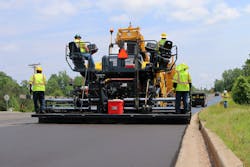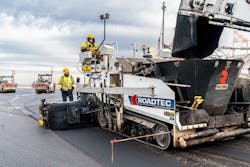Basics, Technology Guarantee Asphalt Paver Prowess
Times are good, not great, for the asphalt paver market, and certainly not as good as they could be with increased government funding for America’s infrastructure.
But large-paver manufacturers are steadfast, continuing to add technology to enhance paving operations.
“The market has leveled off, as expected, as we entered the end of the year,” says Henry Polk, paver product manager, BOMAG. “However, it will improve as the next paving season approaches. Overall, the market is expected to continue to improve due to taxpayer funding and increased market outlooks.”
The category is generally divided into highway-class (larger) and commercial-class asphalt pavers. Equipment market guru Chuck Yengst of Yengst Associates breaks them down according to how they’re put together, and their relative sizes.
“For highway pavers, the tractor or body of the machine is separate from the screed,” Yengst says. “In commercial-class models, the tractor and screed form one unit. Highway pavers are generally more powerful—125+ horsepower—and heavier—19,000+ pounds—than commercial pavers, though sometimes the lines blur and a machine might have more power than 125 horsepower yet weigh less than 19,000 pounds.
“In 2018, sales of commercial and highway-class pavers totaled roughly 1,950 units, up from about 1,500 units in 2014,” Yengst says. “We look for modest sales growth in 2019 and flat to slightly higher sales in 2020 based on current government spending and strong economic conditions for private commercial users.”
If Congress takes action on the Highway Trust Fund and an infrastructure package, the market will rise more steeply, with larger pavers leading the way.
“There is a general correlation between road construction spending and highway-type paver sales,” Yengst says. “Highway Trust Fund renewal is coming up in 2020, and the industry is sorely needing a boost for infrastructure repairs of the nation’s highways. An infrastructure bill has also been proposed by the current administration, but that idea has been blocked repeatedly in the House of Representatives, which is currently controlled by opposing political thinking.”
According to Yengst, Caterpillar and Volvo are the top two companies in the paver category. “Deere’s acquisition of Wirtgen a few years ago was aimed at entering the paver and compactor business on a global scale and being ready when infrastructure spending got moving in the U.S. market,” Yengst says.
Paver purchasing factors
“First, you’ll need to consider where and how the paver will be used,” says Kyle Neisen, product manager, pavers and MTVs, for Roadtec. “Be sure to factor in the application, budget, size of job, environment, and the crew’s experience and skill, as well as preferences. You should also consider if you’ll use an MTV [material transfer vehicle]. Then you’ll need to look at the specific features of the paver, such as flow gates, quick-change heads, and telematics. These are all factors that should be carefully considered before making a buying decision.”
What you need when acquiring an asphalt paver.
Volvo’s Bill Laing, product manager for road products, urges a basic approach to buying, and offers three checklists: paver factors, job-site factors, and paving crew factors (see sidebar at right).
As for making the basic “wheel or tracked?” decision, Laing says, “Tracked pavers are used in all paving applications, but they tend to be preferred over wheels on softer bases because of their traction and flotation. They are also preferred for offset paving because they typically maintain a more stable platform when doing wide-width or offset paving.
“Wheeled pavers are preferred for mill-and-fill applications and where traction isn’t as much of a concern,” Laing says. “Wheeled pavers are also easier to move and travel faster.”
How to reduce paver downtime
“Prevention is always better than repair,” Neisen says. “And many costly issues can be prevented with proper maintenance. One of the easiest things to do is keep the machines clean, every day. A clean machine runs well, which saves time, money, and makes the job site a safer place to work. Cleaning extends the wear life, and when the machine is clean it’s easier to see potential issues. If a machine is caked with asphalt, or caked in dirt, you can’t see clearly if an item is worn or in need of replacement.”
Managers should also keep a close eye on fuel consumption—and take advantage of the technology that manufacturers have built into pavers to help.
“Most modern pavers, such as BOMAG CR and BF Series pavers, offer Ecomode operation to lower fuel consumption,” Polk says. “BOMAG Ecomode features an active engine and hydraulics management system to save up to 20 percent on fuel consumption, as well as significantly reduce operating noise levels. Also, have the paver operator lower the engine rpm in between trucks and during prolonged stops to reduce fuel consumption.”
Having skilled operators—in times when they’re hard to come by—can also keep costs down. Most OEMs offer training classes for paver operators and crews. Volvo has offered its Road Institute for 54 seasons. The current training cycle runs through May.
“With skilled operators hard to come by, it’s also important to keep your best operators happy,” Laing says. “Pavers that are easier to use, safer, and more productive, and that have features that promote operator comfort, will help you retain your operators and could help you recruit new ones. Look for machines with conveniently grouped controls color-coded by function, and seats and consoles that are adjustable for comfort and favorable views of the entire work area.”
Telematics can play an important part in reducing operating costs.
“While it’s important to visually inspect the machine, it’s also imperative to monitor the systems, using telematics such as [Roadtec’s] Guardian,” Neisen says. “This data can help you see when maintenance is needed—if fault codes have been triggered, etc. This information is valuable and allows you to schedule maintenance or repair in the best way to maximize time, money and personnel.”
The latest asphalt paver technology
Volvo’s Laing also keys in on telematics.
“The type of telematics system you have can make a big difference,” Laing says. “Traditional telematics systems usually send fault codes you need to decipher to diagnose issues before they result in a down machine. This is helpful, but advanced telematics can help you prioritize fault codes and decide how to respond. Our ActiveCare Direct, for example, analyzes the data for you and sends a case alert with the probable cause of the issue and a recommended solution. You also get monthly fleet utilization reports, which provide an easy-to-digest overview of a fleet’s performance, efficiency, hours, and instances of machine misuse.”
The ActiveCare Direct concept is now available on the company’s P7110B and P7170B pavers.
“The move to expand this advanced telematics service into our road machinery lineup made sense because of the positive response and rapid adoption among customers using ActiveCare Direct on other pieces of equipment,” Laing says. “They found that it eased the data overload they were experiencing with other telematics systems and gave them the information they needed to proactively address problems and increase uptime.”
Roadtec has also added another layer on top of its telematics.
“Roadtec’s Paver Production Reporting allows you to view the performance of your paver as it relates to real productivity,” Neisen says. “You can see tons per day, the day’s total paving distance, the live speed, and the total tons for the life of the machine. Using Paver Production Reporting, the crew and anyone with access to Guardian Telematics can see real-time production from the paver to see how day is going.”
According to Neisen, the technology allows a look at the overall paving business. “The superintendent can track the efficacy of the crew. Asphalt plants can understand how much more mix is needed until the end of day and how much longer they need to produce mix. Maintenance personnel can track wear parts by tons of asphalt instead of by engine hours, which is a more accurate way to measure wear,” he says.
BOMAG’s Polk points to screed-heating technology as his company’s latest tech. “Magmalife heats the screed plates to paving temperatures in approximately 20 minutes, redefining screed heating,” he says. “Its heat elements are cast into a single aluminum block that offers superior thermal conductivity to transfer heating to the screed bottoms quickly. It also delivers more uniform heat distribution throughout the screed bottom for a tight mat texture without scuffing or tearing.”


